Thai Food Ingredient Glossary
Thai cooking ingredients may seem exotic to Western cooks, but with experimentation you will soon become familiar with these foreign flavors.
Some of the more commonly called for ingredients in Thai recipes are listed here. Please contact us if you need more information or have a recipe that calls for an unfamiliar ingredient.
Basil: European basil can be used as a substitue for all varieties if you cannot find the Thai varieties. But Thai varieties are unique if you can locate them. If not try our ready-made basil chili pastes.
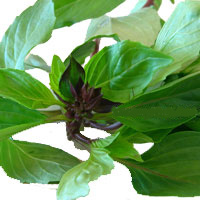
There are several types of basil used in Thai cuisine:
- Holy Basil (bai grapow) There are two types of holy basil: a pale green or white type, and a red type, with purple reddish tinged leaves. Holy basil has a clove-like taste. Store wrapped in a paper towel inside a ziplock bag. Use it soon after buying. Available more readily in summer months, Bai graprow can be difficult to find, but check our online grocery for availability.
- Thai Basil (bai horapha) tastes rather like anise, looks like sweet basil and is therefore sometimes called Thai Sweet Basil. Bai horapa is used in large quantities and in many dishes in Thailand, including stir-fries, salads and soups and Thai red and green curries. This tropical variety is the source of the unusual basil flavor in many Thai dishes. The leaves are smaller and a darker green then Western sweet basil, with purple stems and purple flower buds. The edible leaves and flowers have a distinctly licorice scent. Bai horapa is available year-round in our online Thai grocery. It is also easy to grow and seeds may be ordered online. Or try rooting a fresh stem by placing it in a glass of water.
- Italian Basil (bai rah) has smoother leaves, is darker green with a purple stem and with a more pronounced licorce flavor.
- Lemon Basil (bai menglah) has a lemony flavour with tiny leaves and is usually sprinkled over salads or used in soups. Used much less frequently than sweet basil in Thai cooking.
To store all types of fresh basil, keep the stem ends in a glass of water and cover with a plastic bag and store in the refrigerator. Or, wrap in a paper towel and store in a ziplock bag and refrigerate. Basil can stay fresh for up to one week, but it is best to use as soon as possible as it is very perishable.
See our online Asian grocery to purchase Thai basil.
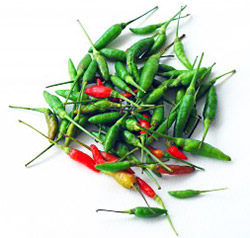 Thai Chili Peppers (prik): Perhaps the most famous ingredient in Thai cuisine is the small fresh chili, known as prik kee noo, literally 'mouse dropping chili'. Actually it is not the spiciest chili pepper in the world, but if one is unaccustomed to eating spicy food, or is caught off guard, they can pack a mighty punch!
Thai Chili Peppers (prik): Perhaps the most famous ingredient in Thai cuisine is the small fresh chili, known as prik kee noo, literally 'mouse dropping chili'. Actually it is not the spiciest chili pepper in the world, but if one is unaccustomed to eating spicy food, or is caught off guard, they can pack a mighty punch!
- Fresh prik kee noo is most often used to make nahm prik , a spicy condiment or soups like tom yum goong, a popular lemon-flavored hot and sour shrimp soup. If you like super hot Thai curry, add whole fresh chilies at the end of cooking.
- Prik chee fah is a larger-sized chili pepper and not as spicy. It literally means chili pointing at the sky, because the chilies grow on the bush pointing upwards. It is a less spicy chili and is often used for garnish.
Thai curry paste is typically made with whole small dried red chilies, stems removed, and seeds intact. If unavailable, try dried whole Mexican chilies, the hottest available, and soak in hot water to soften.
You may purchase Thai dried red chilies for making curry paste in our online grocery.
Even easier to use and just as delicious, though different in flavor, is powdered or ground dried Thai red chilies. Two level tablespoons are equivalent to 10-15 dried chilies. Do not substitute chili powder from your local grocery, as it is actually a combination of spices.
Shop for fresh Thai chilis in the fresh section of our grocery. Shop for dried Thai chilies in our spice section.
 Cilantro (pak chee) & Coriander Seeds: The roots, stems, leaves, and seeds of this common popular herb are all used in Thai cooking.
Cilantro (pak chee) & Coriander Seeds: The roots, stems, leaves, and seeds of this common popular herb are all used in Thai cooking.
- Coriander Root (rahgk pak chee) are indeed the tiny end of the plant, which is often removed before it arrives in the Western market. Pounded in a mortar and pestle, the roots enhance curry pastes and soups. A paste for grilled meats can be made with the pulverized root, white pepper, and garlic. Sometimes difficult to find, try visiting a farmers market or substitute the stems.
- Cilantro Leaves are used extensively in Thai cooking for many salads and to garnish soups. The stems and leaves are eaten raw, along with other raw vegetables like baby Thai eggplant, and other herbs and served with nam prik.
- Corinader Seeds (mellet pak chee) are the seeds of the cilantro plant. Thai coriander seeds are smaller than the seeds available in Western supermarkets and more stongly perfumed. Used extensively in various curry pastes, sauces, and marinades, the best taste is achieved by dry roasting to bring out their perfume and flavors at the time of cooking.
Visit our online grocery to purchase Thai spices including coriander.
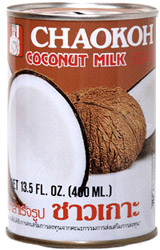 Coconut Milk (nahm gah-tee): The milk is made from fresh coconut by adding just enough water to cover the grated meat of a mature brown coconut, squeezing, and straining. The coconut meat is disgarded after all the juice is extracted. Fresh coconut milk is splendid indeed! The water inside of the coconut may be drank as a beverage or thrown away (note this water is not the coconut milk!).
Coconut Milk (nahm gah-tee): The milk is made from fresh coconut by adding just enough water to cover the grated meat of a mature brown coconut, squeezing, and straining. The coconut meat is disgarded after all the juice is extracted. Fresh coconut milk is splendid indeed! The water inside of the coconut may be drank as a beverage or thrown away (note this water is not the coconut milk!).
The use of coconut milk in Thai cooking is a feature that the Thai have in common with other Southeast Asian and Pacific countries. Coconut milk has the quality of blending together and mellowing the flavors of the dishes in which it is used. Used as a liquid medium in meat and fish curries, it offsets the pungency of many of the stronger ingredients. A Westerner might consider coconut as the dairy substitute of Southeast Asia!
Coconut milk is also available canned.
When using canned coconut milk, follow the recipe directions whether to stir the contents or not. The heavier cream is on the top of the watery part.
Store unused coconut milk portions in a ziplock bag in the refrigerator or freezer. Use within a few days if you refrigerate it. To use frozen milk, break off a chunk and pop into your curry or soup, bring to a quick boil only to cook through the meats and vegetables. Be careful when boiling as the milk will tend to seperate if you boil it too hard and long.
Buy canned coconut milk in our grocery.
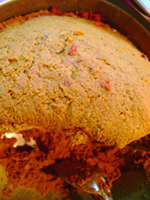 Curry Paste (kreung-geng): Curry paste is made in a mortar and pestle (or blender) by pulverizing together chilies, peeled garlic, lemon grass, fresh turmeric, sea salt, and shrimp paste (kapee). This basic paste is the foundation of every Thai curry (follow this link for an extensive discussion of Thai curries and curry pastes).
Curry Paste (kreung-geng): Curry paste is made in a mortar and pestle (or blender) by pulverizing together chilies, peeled garlic, lemon grass, fresh turmeric, sea salt, and shrimp paste (kapee). This basic paste is the foundation of every Thai curry (follow this link for an extensive discussion of Thai curries and curry pastes).
Today in Thailand, most Thais prepare curry paste in a small electric blender. The mortar and pestle, many will argue, produces a far superior paste.
Prepared curry paste is also conveniently available canned. Use approximately 3 tablespoons per cup of liquid to prepare Thai curry.
Buy ready-prepared curry pastes in our grocery.
Eggplant (makeau): There are several different types of eggplant used in Thai cusine ranging from the tiny "pea" eggplant not commonly available outside of Thailand to the now more well-known Thai Eggplant.
Pea Eggplant (makeau phuang), pea aubergine or bitter eggplant are tiny Thai eggplants which grow in clusters and look like oversized green peas (but taste nothing like peas). They are eaten raw with nam prik (spicy chili pastes) and added to curries (especially green curry). Image copyright visual7/istockphoto.com
Thai Eggplant (makeau prau): green and white round golf-ball sized eggplants are served raw and crunchy or steamed until soft alongside spicy curries or on a mixed platter of raw and cooked vegetables and herbs in Thailand. You can purchase Thai Eggplant in our oline grocery for Thai food.
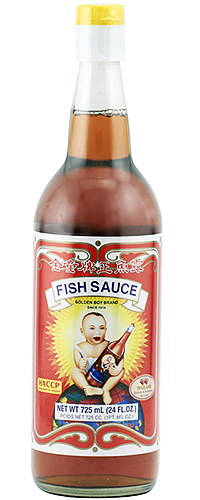 Fish Sauce (nam pla): The most essential cooking ingredient for Thai food is perhaps fish sauce. This is Thailand's equivalent to soy sauce or table salt. Uncooked it has an unpleasant smell, but it adds a subtle flavor, for which there is no substitute. Small anchovy fish are fermented and the resulting liquid is strained and bottled.
Fish Sauce (nam pla): The most essential cooking ingredient for Thai food is perhaps fish sauce. This is Thailand's equivalent to soy sauce or table salt. Uncooked it has an unpleasant smell, but it adds a subtle flavor, for which there is no substitute. Small anchovy fish are fermented and the resulting liquid is strained and bottled.
Add a bit more fish sauce at the end of cooking to adjust to taste and cook a minute longer. This is perhaps the most important ingredient in Thai cooking, so by all means give it a chance. The key to appreciating it is to buy only the best quality fish sauce available. Look for clear amber colored liquid with no sediment. Find out more about how the best fish sauce is produced.
Shop for authentic Thai fish sauce in our grocery.
Galangal Root (hea-uh kah): Galangal or galanga root is similar to ginger root, but more delicate in flavor and texture. Preferably fresh, but also available dried in slices or ground, it adds a unique fresh flavor to Thai soups and curries.
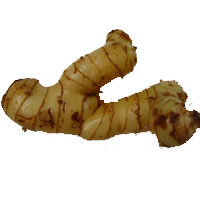 The most popular Thai dish using fresh galangal is tom kah gy, chicken cooked in coconut milk. Dried pieces of galangal can also be substituted in this dish. Galangal is also known as "laos" in Indonesia and "lengkaus" in Malaysia.
The most popular Thai dish using fresh galangal is tom kah gy, chicken cooked in coconut milk. Dried pieces of galangal can also be substituted in this dish. Galangal is also known as "laos" in Indonesia and "lengkaus" in Malaysia.
Shop for fresh galangal root or dried galanga in our grocery.
Garlic (gra-tium): Fresh garlic is a key ingredient for many Thai dishes, including curry paste, which incorporates up to 30 small cloves in a paste. Also use in the majority of stir-frys by first smashing the clove with the side of a heavy cleaver, before adding to hot oil. Stir once and then add the remaining ingredients called for in your stir-fry recipe. Sliced very thin you can also add fresh garlic to Thai beef salad.
Note that Thai garlic is less than half the size of American commercial type. That means you need to re-adjust the recipe if it was written in Thailand (see our Thai cookbooks). Also the outside skin is much thinner, so peeling Thai garlic is not as necessary as it is in the West.
 Grachai (gra-chai), rhizome or lesser ginger: This root is of the same family as ginger and galangal, but is not as pungent and smaller. Sold fresh occassionally, pickled in a jar or dried ground it is sometimes labelled kachai. Store fresh refrigerated in a ziplock bag. This is a must for jungle curry.
Grachai (gra-chai), rhizome or lesser ginger: This root is of the same family as ginger and galangal, but is not as pungent and smaller. Sold fresh occassionally, pickled in a jar or dried ground it is sometimes labelled kachai. Store fresh refrigerated in a ziplock bag. This is a must for jungle curry.
Try grachai in our yellow chicken curry recipe.
 Kaffir Lime (ma-groot): This distinctly Thai ingredient is essential to many dishes. Both the leaves and the fruit of the Kaffir Lime tree are used in Thai cusine.
Kaffir Lime (ma-groot): This distinctly Thai ingredient is essential to many dishes. Both the leaves and the fruit of the Kaffir Lime tree are used in Thai cusine.
- The kaffir lime leaf is a wonderful aromatic addition to soups like tom yum. Also added to Thai stir fry, curry and salads - the results are fragrant and exotic. You may buy fresh kaffir lime leaves in our online grocery.
- Kaffir limes: It is generaly difficult to find the fresh Kaffir lime fruit in the USA (but please check our online Thai grocery for current availability). You can try growing your own kaffir lime tree in a container, but it most likely will not bear fruit. Visit Four Winds Growers. Sometimes, you may be able to buy the dried peel of the kaffir fruit also in our online grocery.
- Dried kaffir leaves and rind: Dry and frozen kaffir lime leaves are also available. Dried kaffir lime leaves are very good in liquid dishes, like curry and soup (shop online in our Thai spices section).
Shop for Thai ingredients in our grocery!









 Kaffir Lime (ma-groot): This distinctly Thai ingredient is essential to many dishes. Both the leaves and the fruit of the Kaffir Lime tree are used in Thai cusine.
Kaffir Lime (ma-groot): This distinctly Thai ingredient is essential to many dishes. Both the leaves and the fruit of the Kaffir Lime tree are used in Thai cusine. 
